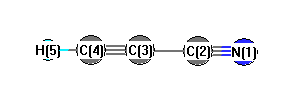Geometric Data

Point Group C∞v
Internal coordinates
distances (r) in Å, angles (a) in degrees, dihedrals (d) in degrees
| Description |
Value |
unc. |
Connectivity |
Reference |
Comment |
| Atom 1 |
Atom 2 |
Atom 3 |
Atom 4 |
| rCH |
1.062 |
0.001 |
4 |
5 |
|
|
1998Kuc |
re |
| rCC |
1.206 |
0.001 |
3 |
4 |
|
|
1998Kuc |
|
| rCC |
1.376 |
0.001 |
2 |
3 |
|
|
1998Kuc |
|
| rCN |
1.161 |
0.001 |
1 |
2 |
|
|
1998Kuc |
|
Cartesians
| Atom |
x (Å) |
y (Å) |
z (Å) |
| N1 |
0.0000 |
0.0000 |
1.9018 |
| C2 |
0.0000 |
0.0000 |
0.7413 |
| C3 |
0.0000 |
0.0000 |
-0.6351 |
| C4 |
0.0000 |
0.0000 |
-1.8409 |
| H5 |
0.0000 |
0.0000 |
-2.9033 |
Atom - Atom Distances 
Distances in Å
| |
N1 |
C2 |
C3 |
C4 |
H5 |
| N1 |
|
1.1605 | 2.5369 | 3.7427 | 4.8051 |
| C2 |
1.1605 |
|
1.3764 | 2.5822 | 3.6446 |
| C3 |
2.5369 | 1.3764 |
|
1.2058 | 2.2682 |
| C4 |
3.7427 | 2.5822 | 1.2058 |
|
1.0624 |
| H5 |
4.8051 | 3.6446 | 2.2682 | 1.0624 |
|
Calculated geometries
for HCCCN
+ (Cyanoacetylene cation).
Experimental Bond Angles (degrees) from cartesians 
| atom1 |
atom2 |
atom3 |
angle |
|
atom1 |
atom2 |
atom3 |
angle |
| N1 |
C2 |
C3 |
180.000 |
|
C2 |
C3 |
C4 |
180.000 |
| C3 |
C4 |
H5 |
180.000 |
Bond descriptions
Examples: C-C single bond, C=C, double bond, C#C triple bond, C:C aromatic bond
| Bond Type |
Count |
| C#N |
1 |
| C-C |
1 |
| C#C |
1 |
| H-C |
1 |
Connectivity
| Atom 1 |
Atom 2 |
| N1 |
C2 |
| C2 |
C3 |
| C3 |
C4 |
| C4 |
H5 |








